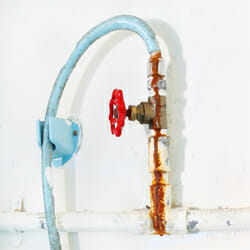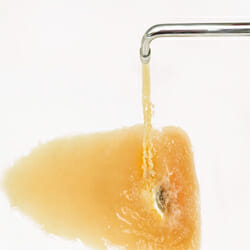Our health and well-being depend on having access to clean and safe drinking water. However, there are times when the water coming out of our taps may not be up to the standards we expect. One common issue that many people face is brown tap water. If you turn on your faucet and see discoloured water, it’s natural to feel concerned and wonder what is causing this problem.
The reason why tap water may be brown can vary depending on several factors. One possible cause is sediment and rust buildup in pipes. Over time, minerals and sediment can accumulate in plumbing, causing water to turn brown or red. Another cause may be the presence of algae and other organic matter, which can grow in water sources and cause discoloration. Additionally, high levels of minerals like manganese and iron can also make water appear brown.
Understanding the potential reasons for brown tap water is crucial to take appropriate actions to address the issue. In the following sections, we will explore the various causes of brown tap water and provide you with helpful tips on what to do if you encounter this problem.
The Significance of Safe and Clean Drinking Water

Water is vital for many of our body’s functions, and it’s essential to keep it clean and safe to avoid illnesses and diseases. When water is contaminated, it can cause numerous health problems, including gastrointestinal illnesses, skin rashes, and even more severe conditions like kidney damage.
In this blog, we will focus on one particular issue that can affect the safety and cleanliness of tap water: brown tap water. We’ll discuss the potential causes of brown tap water, the signs that it may be unsafe to drink, and what steps you can take to address the issue. Ultimately, by learning more about the importance of clean and safe drinking water, you can take the necessary steps to protect your health and ensure the water you consume is safe.
What will we be Covering?
In this blog, we will provide you with a comprehensive guide on what to do if you encounter brown tap water. We will cover the potential causes of brown tap water, the signs that it may be unsafe to drink, and the steps you can take to address the issue.
In addition, we’ll provide you with helpful tips on how to determine whether your tap water is safe to drink, as well as precautions you can take to limit your exposure to contaminated water. We’ll also discuss how to address any issues with your home plumbing and how to work with your water provider or municipality to resolve the issue.
Ultimately, our goal is to provide you with the information you need to protect yourself and your family from the potential health risks associated with brown tap water. By following the advice and recommendations outlined in this blog, you can ensure that the water you consume is clean and safe and get the solution of getting rid of brown water.
4 Potential Causes of Brown Tap Water
1. Sediment and Rust Buildup in Pipes
One of the most common causes of brown tap water is the accumulation of sediment and rust buildup in pipes. Over time, mineral deposits can build up in plumbing and cause discoloration. This is especially true in older homes or buildings with ageing plumbing systems.
Sediment buildup can also occur when there is a disruption in the water supply, such as a water main break or construction work. When the water flow is disrupted, sediment and debris can enter the pipes and cause water to turn brown or discoloured.
If you notice that your tap water is brown, it’s important to determine whether the discoloration is caused by sediment and rust buildup in pipes. This will help you take the necessary steps to address the issue and ensure that your water is safe to drink.
2. Presence of Algae and Other Organic Matter
Another potential cause of brown tap water is the presence of algae and other organic matter. This is more likely to occur in water sources that are exposed to sunlight and heat, such as open reservoirs or lakes.
Algae and other organic matter can give water a brown or green tint and cause it to have an unpleasant odour or taste. While this type of discoloration is not typically harmful to human health, it can be a sign that the water is not being properly treated or disinfected.
If you suspect that the brown tap water in your home is caused by the presence of algae or other organic matter, it’s important to contact your water provider or municipality to report the issue. They can investigate the problem and take steps to ensure that the water is being properly treated and disinfected to protect your health.
3. Corrosion of Pipes
Corrosion of pipes can also cause brown tap water. When pipes corrode, they can release metal ions, which can give the water a brown or reddish tint. This is especially true in homes or buildings with ageing plumbing systems that have not been properly maintained or replaced.
Corrosion of pipes can also be caused by a variety of factors, including exposure to acidic water, high water pressure, or poor water quality. If you suspect that the brown tap water in your home is caused by corroded pipes, it’s important to have your plumbing system inspected by a licensed plumber.
They can determine whether the pipes need to be repaired or replaced and help you take the necessary steps to address the issue. In addition, you should contact your water provider or municipality to report the problem, as corrosion of pipes can also affect the quality of water in your community.
Related Articles:
4. Presence of Chemicals or Contaminants
In some cases, brown tap water may be caused by the presence of chemicals or contaminants in the water supply. This can occur when chemicals are accidentally released into the water system, or when water sources are contaminated by runoff from agricultural or industrial activities.
Chemicals and contaminants can give water a brown or discoloured appearance, as well as an unusual taste or odour. They can also pose a serious health risk, especially if they are present in high concentrations.
If you suspect that the brown tap water in your home is caused by the presence of chemicals or contaminants, it’s important to contact your water provider or municipality immediately. They can test the water supply and determine whether it is safe to drink. In some cases, you may need to take additional steps to filter or treat the water to remove any harmful substances.
4 Steps to Take if Your Tap Water is Brown
1. Determine the Cause of the Discoloration
The first step to take if you notice that your tap water is brown is to determine the cause of the discoloration. As we’ve discussed, there are several potential causes of brown tap water, including sediment buildup, algae and other organic matter, corrosion of pipes, and the presence of chemicals or contaminants.
To determine the cause of the discoloration, you can start by running your cold water tap for a few minutes. If the water clears up, the discoloration may have been caused by sediment buildup in the pipes. However, if the water remains brown or discoloured, it’s important to contact your water provider or municipality to report the issue and request a water test.
In some cases, the water provider may be able to determine the cause of the discoloration and provide guidance on how to address the issue. However, if the cause of the discoloration is not immediately apparent, it may be necessary to hire a licensed plumber or water treatment specialist to inspect your plumbing system and test the water quality.
2. Avoid Using Brown Tap Water for Drinking or Cooking
If you notice that your tap water is brown, it’s important to avoid using it for drinking or cooking until you determine the cause of the discoloration and receive confirmation from your water provider that the water is safe to consume. Even if the water has no taste or odour, it may still contain harmful contaminants that pose a risk to your health.
In the meantime, you can use bottled water or water from a known safe source for drinking and cooking. You should also avoid using brown tap water to brush your teeth, wash dishes, or bathe, as the contaminants in the water can be absorbed through the skin or inhaled as steam.
If you have concerns about the safety of your water supply, you can contact your water provider or municipality to request a water quality report or request a home water testing kit to test the water yourself. Additionally, you can consult with a licensed plumber or water treatment specialist for guidance on how to improve the quality of your water.
3. Flushing the Pipes
If the cause of the brown tap water is sediment buildup in the pipes, one solution is to flush the pipes. Flushing the pipes involves running your cold water tap for several minutes to clear out any sediment or debris that may have accumulated in the pipes.
To flush your pipes, start by running the cold water tap in your kitchen or bathroom for at least 15 to 20 minutes. This should help clear out any sediment or debris that may have accumulated in the pipes. If the water does not clear up after flushing the pipes for 20 minutes, it’s important to contact your water provider or municipality to report the issue.
In some cases, flushing the pipes may not be enough to address the issue. If the brown tap water persists, it may be necessary to hire a licensed plumber to inspect your plumbing system and determine whether the pipes need to be repaired or replaced.
Also Read: Choosing the Right Pipes for Your Plumbing System
4. Installing a Water Filtration System
If your tap water is consistently discoloured or has an unpleasant taste or odour, you may want to consider installing a water filtration system. A water filtration system can help remove sediment, chemicals, and other contaminants from your tap water, improving its quality and taste.
Numerous types of water filtration systems are available, including reverse osmosis systems, ion exchange filters, and activated carbon filters. Each type of system has its own unique features and benefits, so it’s important to research your options and consult with a licensed plumber or water treatment specialist to determine which system is right for your needs.
Keep in mind that installing a water filtration system can be a significant investment, so it’s important to weigh the costs and benefits before making a decision. Additionally, it’s important to follow the manufacturer’s instructions for maintenance and replacement to ensure that the filtration system continues to function effectively.
Overview
To summarise, if your tap water is brown, it’s important to determine the cause of the issue and take steps to address it as soon as possible. Some possible causes of brown tap water include sediment buildup, corrosion of pipes, or issues with your water supply.
To address the issue, you may need to flush your pipes, contact your water provider or municipality, or hire a licensed plumbing to inspect your plumbing system. Additionally, you may want to consider installing a water filtration system to improve the quality and taste of your tap water.
To prevent brown tap water in the future, it’s important to regularly flush your pipes and consider installing a water softener or other treatment system if you live in an area with hard or mineral-rich water. By taking these steps, you can help ensure that your tap water is clean, safe, and refreshing to drink.






 Enquire
Enquire